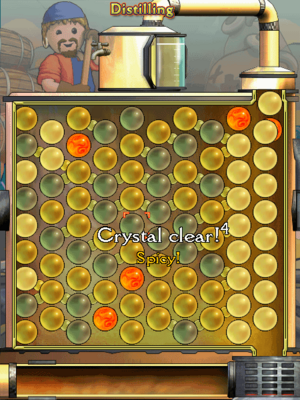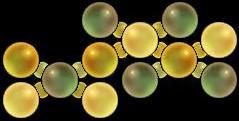Distilling
Distilling is the fine art of turning sugar cane, wood, and iron into rum. It is free to play one day a week.
There are three types of rum in the YPP world - swill, grog and fine rum. The distilling puzzle is used to make all of them, plus hemp oil and mugs.
In the distilling puzzle, there are three main types of pieces (white, brown, and black) which represent parts of the mixture to be distilled into rum. There are also orange spices, and burnt white pieces which are added if any white pieces are wasted.
Pieces are arranged into columns which periodically shift one place to the right across the screen. When this occurs, the right-most column is removed, either going up into the rum or down into the furnace, and a new column of pieces appears on the left. Whether the right-most column goes up or down is determined by the pieces in the column. If there are more black pieces than white (including burnt white) pieces, the column goes down into the furnace; if not, it goes up into the rum. Columns with equal numbers of black and white pieces (including columns with only brown pieces) will go up into the rum.
One burnt piece replaces a white piece for every two white pieces that are wasted, i.e. sent down to the furnace. Sending the first white piece downwards will not generate any burnt pieces. However, if one more white piece is sent down during the game, even if that second piece is in a different column, one white piece will be replaced with a burnt piece in the next column that contains any whites. This pattern continues through the game: the third white piece sent down generates no burnt pieces, the fourth white piece sent down generates one burnt piece, etc., etc.
Two pieces can be swapped with one another if there is a link between them. At first glance the links may appear to be random, but well defined rules determine exactly when pieces can be swapped: white swaps upward with black, and downward with brown; brown swaps upward with white and downwards with black, and black completes the pattern by swapping upward with brown and downward with white. Spice pieces do not swap. Burnt white pieces work just like regular white ones, but they prevent a score of Crystal Clear for that column.
Contents
Scoring
A pirate's score is determined only by the contents of the columns that are sent up, with a small penalty for wasted spice pieces. Spice pieces score the highest, followed by white pieces, brown pieces, black pieces, and burnt white pieces, which are the worst to send up. If a column contains no black or burnt white pieces and more white pieces than brown, it scores moderately well and is described as 'Smooooooth'. If a column consists of white pieces only, it scores highly and is described as 'Crystal Clear'. If a column consists of an equal number of white and black pieces, the column scores badly and is described as 'Blecch!'. Columns with only brown pieces score fairly low, but don't receive a 'Blecch!' message. Spices increase the value of a column.
Burnt white pieces count as white pieces when determining whether a column will go up or down, but they have a significantly negative score if sent up.
The quality and progress of the rum being produced is represented by the container on top of the board. The more brown and black pieces that go up, the darker the liquid becomes; if only white pieces are sent up, the liquid will be clear (hence the name for columns of pure white). When twelve columns have been sent upwards, the liquid reaches the top and the puzzle ends (if the columns weren't 12 consecutive 'Crystal Clears', described below).
It is possible to improve scores further by sending up consecutive, rather than separate, pure white columns. The more crystals clear columns sent consecutively, the higher the score.
The quality of the labor that is produced (basic, skilled, or expert) depends on how the score compares to the scores of others that have played the puzzle. Different distillery products require different quantities and qualities of labor.
The time to complete the puzzle has no bearing on the puzzle's score. Abandoning the puzzle after several pieces have been moved affects that pirate's standing negatively.
CC^12 and beyond
Getting two Crystal Clears in a row is called a 'Crystal Clear^2', which players abbreviate to CC^2. In normal circumstances, the game ends immediately after the twelfth column is sent up. However, if a player manages to get a chain of twelve Crystal Clears (CC^12), the puzzle continues until a column that is NOT 'Crystal Clear' is sent either to the rum or furnace, allowing even longer consecutive CC combos (CC^13, CC^14, etc.) and better scores. This ONLY occurs after doing a CC^12 and in no other situations (i.e. sending a CC^10 and after that a CC^2 will NOT allow the player to continue). While getting a CC^12 or higher takes considerable speed and dexterity in moving the pieces as well as the ability to make strategic decisions quickly, there are many distillers who achieve CC^12 games regularly; top distillers are able to achieve a CC^12 or higher more than half of the time.
After achieving a CC^12, expert distillers challenge themselves further by trying for a higher CC count or reducing the time used per game, often below three and a half minutes. (A slow game may take around eight minutes.) Some very competitive distillers also attempt to record CC^12 games with the maximum amount of spice used, while keeping wasted spice to a minimum.
Goals and strategy
The key to improving at distilling is to set for oneself suitable goals. Initially, one should only attempt to ensure that no white pieces are wasted and no black pieces sent up, by assembling columns consisting only of white and brown. As one becomes more familiar with the way in which pieces swap, one can move on to attempting to create columns of pure white, incorporating spice pieces where possible.
Only having reached this stage is it useful to attempt to construct consecutive crystal clear columns. Initially, whites on the far right of the board can be used to make a single crystal clear, and this will buy some time with which one can attempt to make consecutive CCs with the rest of the board. After being able to construct CC^2s and CC^3s, the practice of dragging pieces rather than click-swapping them will start to become both necessary and more intuitive. It should become clear that the best way to construct a long string is to initially shift white pieces to the left, then when the block of white approaches the final column, start shifting the newly generated white pieces to the right to add on to the white block. At this point one must keep an eye on the furnace in order to avoid attempting to build a final crystal clear column when there is not enough time to do so.
Once a players crsytal clear chain has come to an end, if they cannot perform another longer chain, then it is advisable to dismiss the puzzle. For example, if a player sends a CC^8, following it with a CC^4 will reduce the players overall score. This is because the score is divided by the number of columns sent upwards, so sending lower scoring columns, such as those from a CC^4 would reduce the players average score per column.
Moving on from this point towards the eventual goal of achieving a CC^12 is extremely challenging, and it is only at this point that the many expert distilling videos (see links below) will prove instructive.
Immovable pieces
The algorithm used to determine where spices are placed has no sanity test and will, on occasion, create non-spice pieces that are completely surrounded by spice pieces and/or the top/bottom edge of the board. Such pieces are completely immobile and may make playing a perfect game during that round impossible.
Control and technical issues
- On slower computers, the piece swapping animations are less smooth which makes it harder to move pieces at maximum speed.
- The top right hand corner displays the distilling shoppe/stall scene during the puzzle. Activity in the scene, especially players entering the scene, may cause the distilling game to lag slightly, making the controls slightly erratic.
- The game can be controlled in two ways. One can click on one piece and then click on an adjacent piece to swap those pieces. Experts rarely, if ever, use this method as it is extremely slow. One can also drag a piece and the game will continue to move the selected piece as long as one drags it over pieces that create legal swap moves. Problems can occur if a pirate accidentally clicks on a piece that they did not intend to move--after a misclick, it can be difficult to drag another piece as the game expects to make a swap move with the first piece.
- A common beginner mistake is to make drag attempts that are too fast or too sloppy, which either move much faster than the pieces can swap or accidentally go over pieces that the currently selected piece cannot swap with. In such cases, the game stops moving the selected piece, even if there is a legal swap path from the selected piece to the current mouse position. Another common beginner mistake is to drag the selected piece too far and make an unintended swap. This can cause strategic problems as no swap is directly reversible. Learning how to make precise dragging movements is part of the distilling game and these types of mistakes can be reduced with practice.
- Originally the game contained a bug that would booch the linking of a piece that was being dragged as the columns are shifting to the right; the piece would no longer be movable, and it would be necessary to perform other swaps nearby to fix this. The bug has been fixed for the most part, but does still occur very occasionally.
Historical notes
- Prior to release 2007-07-17 abandoning the distilling puzzle would not hurt the player's standing, regardless of the number of pieces moved.
- The ability to construct longer CC streaks than CC^12 was introduced in release 2007-12-12. Prior to that the puzzle always ended with the 12th column sent upwards into the rum and building a longer combo (CC^13, CC^14 etc.) would not affect the puzzle score (though still some players would challenge themselves to do it).
Ultimate list
| Cerulean | Emerald | Ice |
|---|---|---|
| Jade | Meridian | Obsidian |
| Opal | ||
Trophies
The following trophies are related to distilling:
- Distilling Trophies
External/other links
- Commonly discussed ideas from Game Design
- Official game documents
- Distilling tutorial
- Sonny's tutorial video with commentary
- Sonny's distilling music video
- Rubyspoon's distilling music videos
- Distilling hints (a little outdated, in that it's now harder to get incredibles)
| |
| See also: Labor |












